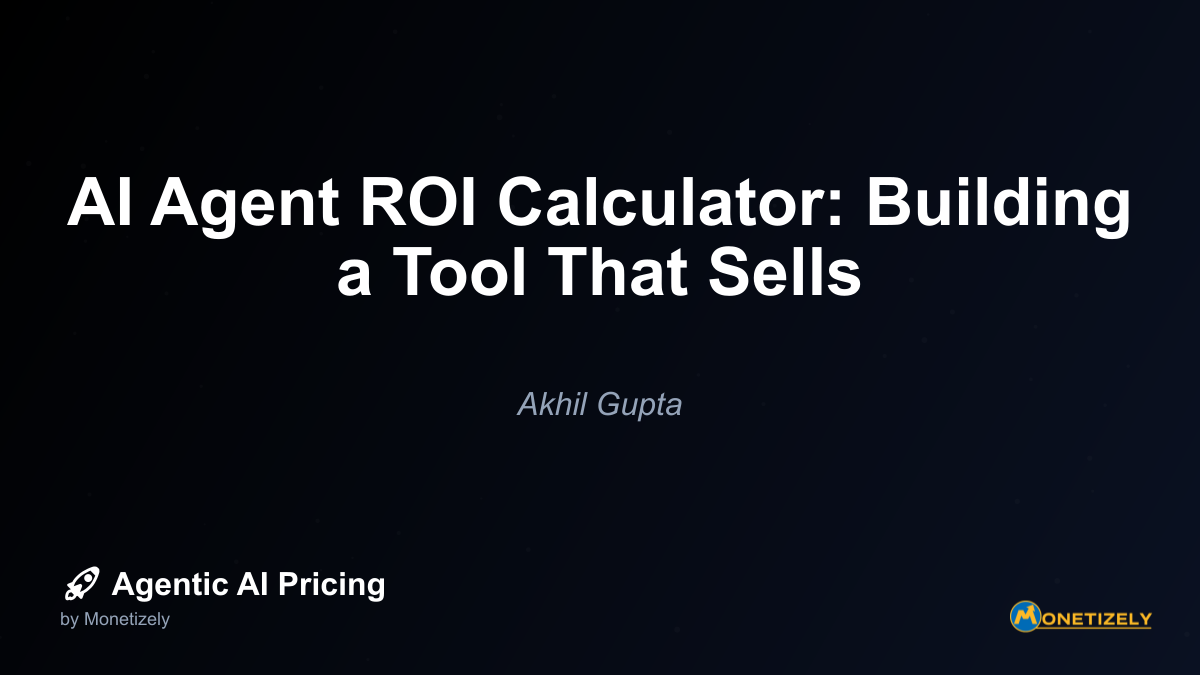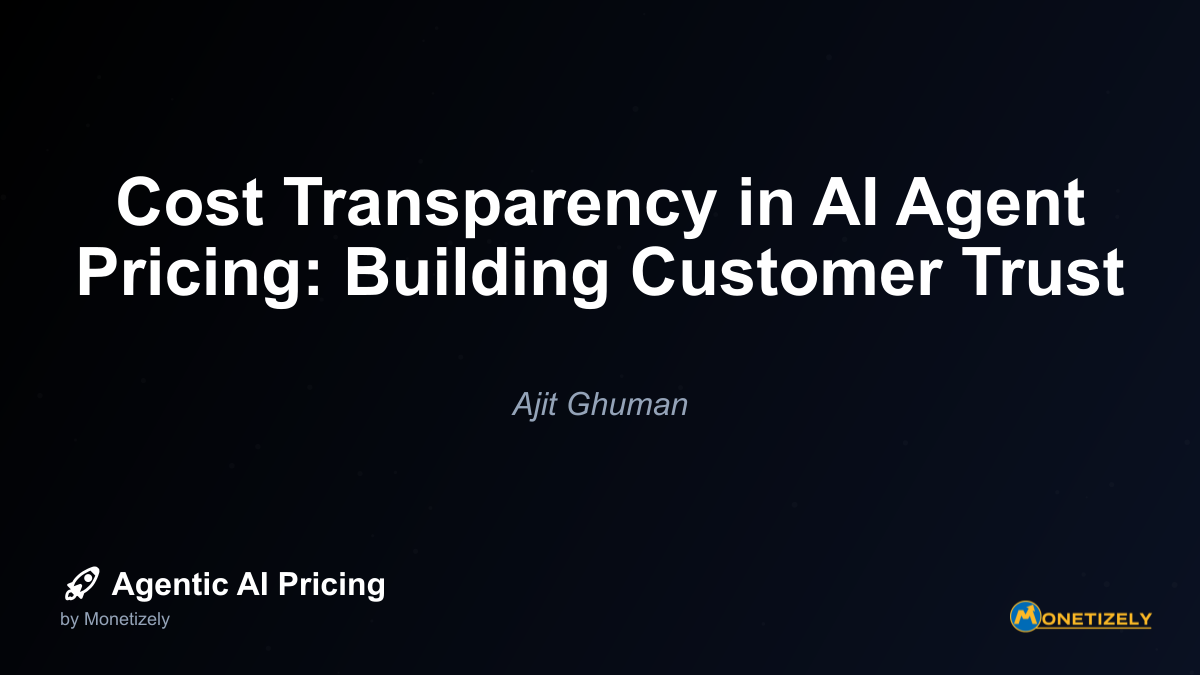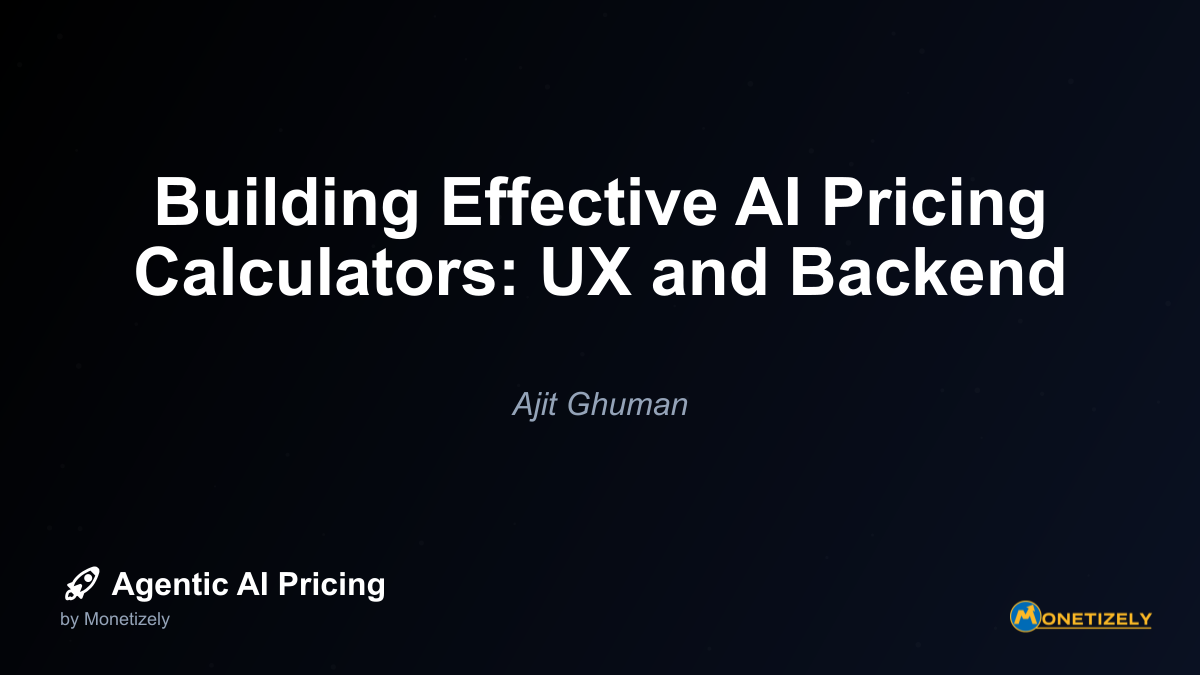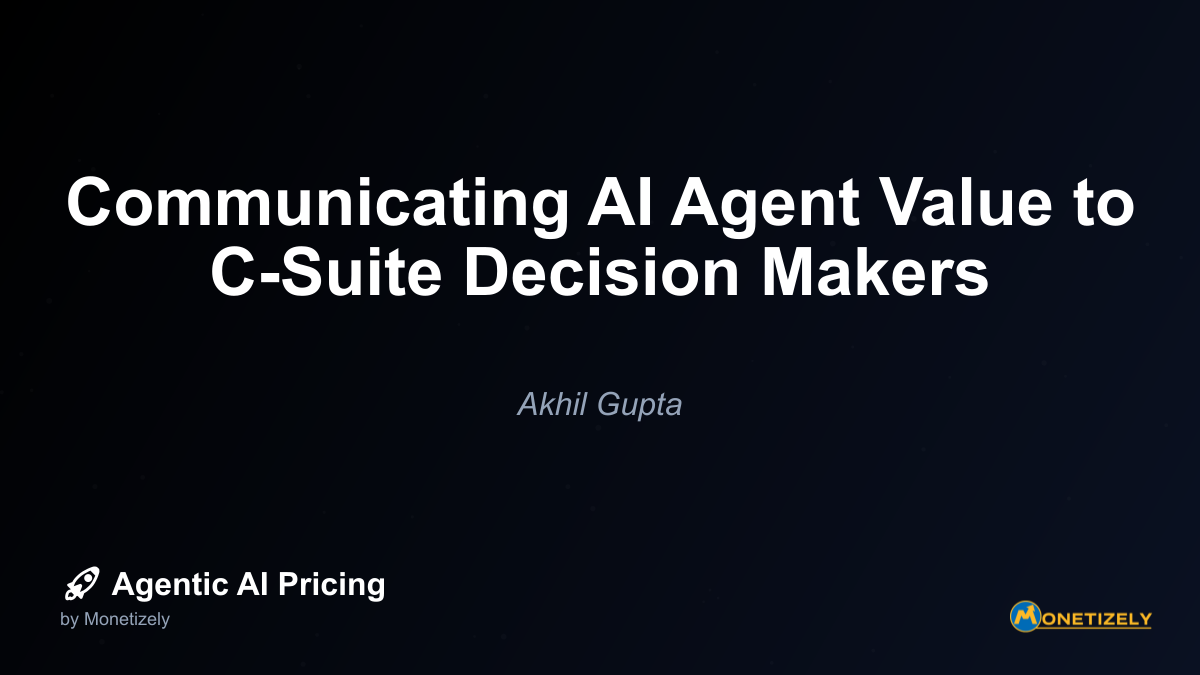· Akhil Gupta · Communication & Messaging · 6 min read
AI Agent ROI Calculator: Building a Tool That Sells
AI and SaaS Pricing Masterclass
Learn the art of strategic pricing directly from industry experts. Our comprehensive course provides frameworks and methodologies for optimizing your pricing strategy in the evolving AI landscape. Earn a professional certification that can be imported directly to your LinkedIn profile.

Step 5: Testing and Refinement
The most effective ROI calculators undergo rigorous testing and continuous refinement. Consider implementing:
- A/B testing different input configurations to identify the optimal balance between simplicity and depth
- User testing sessions to observe how prospects interact with the calculator
- Conversion tracking to measure completion rates and lead quality
- Feedback mechanisms to capture user suggestions
- Regular updates based on new customer data and evolving value metrics
Pay particular attention to where users abandon the calculator. High drop-off rates at specific inputs may indicate confusion, skepticism about default values, or reluctance to share certain information.
Step 6: Training Your Sales Team
A sophisticated ROI calculator is only as effective as the sales team’s ability to leverage it in conversations. Provide training on:
- When to introduce the calculator in the sales process
- How to guide prospects through the inputs
- Strategies for discussing the results and addressing skepticism
- Ways to use calculator results to advance deals
- Techniques for customizing the conversation based on calculator insights
Sales representatives should understand not just how to operate the calculator but also the underlying value model so they can have credible conversations about the assumptions and methodologies.
Common ROI Calculator Pitfalls to Avoid
Even well-designed calculators can fail to drive conversions if they fall into these common traps:
1. Overpromising Results
Nothing undermines credibility faster than unrealistic ROI projections. Avoid:
- Inflated improvement percentages not supported by actual customer data
- Cherry-picking best-case scenarios as “typical” results
- Ignoring implementation and change management costs
- Assuming immediate full adoption and perfect execution
Instead, build conservative models that under-promise and allow your customers to over-achieve, creating positive reference stories.
2. Neglecting Implementation Timelines
ROI doesn’t happen overnight. Calculators that ignore implementation timelines create unrealistic expectations that lead to disappointed customers.
Include:
- Phased benefit realization curves
- Implementation and training periods before full value realization
- Time-to-value metrics based on actual customer experiences
- Options to model different implementation approaches
This time-based approach sets realistic expectations and helps prospects understand the journey to value realization.
3. Focusing Only on Cost Reduction
Many AI agent ROI calculators overemphasize cost reduction while ignoring revenue enhancement and strategic benefits. This narrow focus:
- Positions your solution as a mere efficiency play
- Makes price the primary decision criterion
- Misses opportunities to align with growth and innovation priorities
- Fails to engage non-financial stakeholders
The most compelling calculators balance efficiency gains with growth opportunities and strategic advantages to appeal to multiple decision-makers.
4. Hiding the Methodology
Some vendors treat their ROI methodology as proprietary, hiding the calculations behind vague claims. This approach:
- Creates skepticism among financially sophisticated buyers
- Prevents customization to match specific customer situations
- Limits the calculator’s credibility with financial decision-makers
- Reduces its effectiveness as a sales tool
Transparency builds trust. Providing access to your calculation methodology demonstrates confidence in your value proposition.
Advanced Techniques for High-Converting ROI Calculators
To elevate your ROI calculator from good to exceptional, consider these advanced approaches:
Personalization Through Industry Benchmarks
Generic calculations rarely resonate as strongly as industry-specific ones. Consider:
- Segmenting default values by industry
- Providing comparative benchmarks (“companies like yours typically see…“)
- Offering case studies filtered by industry
- Customizing output language to match industry terminology
This personalization makes results feel more relevant and credible to prospects in specific sectors.
Scenario Modeling
Advanced calculators allow prospects to explore multiple scenarios, helping them build internal consensus around different implementation approaches:
- Basic vs. comprehensive implementation
- Phased vs. all-at-once deployment
- Department-specific vs. enterprise-wide adoption
- Different levels of integration with existing systems
This scenario-based approach helps prospects visualize different paths to value and choose the one that best fits their situation.
Competitive Comparison Features
Some of the most effective ROI calculators subtly highlight competitive advantages by allowing prospects to compare approaches:
- Your AI agent solution vs. manual processes
- Your solution vs. generic AI implementations
- Your approach vs. building in-house capabilities
- Your offering vs. competitive alternatives (without naming competitors)
These comparisons help prospects understand your unique value proposition in context.
Integration with Total Cost of Ownership (TCO) Analysis
ROI tells only part of the story. Integrating TCO analysis provides a more complete financial picture by accounting for:
- Implementation and integration costs
- Training and change management expenses
- Ongoing maintenance and support requirements
- Future scaling and enhancement investments
This comprehensive approach preemptively addresses cost objections by framing them within the broader context of value creation.
Making Your ROI Calculator a Lead Generation Powerhouse
Beyond its role in the sales process, your ROI calculator can become a powerful lead generation tool when properly positioned:
Strategic Placement Options
Consider these placement strategies to maximize calculator engagement:
- Pricing page companion - Place alongside pricing information to justify investment
- Dedicated landing page - Create a standalone experience with supporting content
- Blog post integration - Embed simplified versions within relevant content
- Sales proposal component - Include personalized calculations in formal proposals
- Webinar follow-up - Offer access as a next step after educational events
Each placement should include clear context about what the calculator provides and why it matters.
Lead Capture Optimization
Balance information collection with user experience by:
- Requiring minimal information upfront (email only)
- Progressively requesting additional details as users engage
- Offering to email results in exchange for contact information
- Providing enhanced analysis for users who complete profiles
The goal is to create value before requesting information, establishing a fair value exchange.
Content Ecosystem Integration
Your ROI calculator shouldn’t exist in isolation. Create supporting content that:
- Explains the methodology in detail
- Provides case studies validating the calculations
- Offers implementation guides for achieving projected results
- Addresses common questions and objections
This ecosystem builds credibility around your calculator and nurtures prospects who aren’t ready to engage with sales.
Measuring Calculator Effectiveness
To continuously improve your calculator’s impact on conversions, track these key metrics:
- Engagement rate: Percentage of visitors who begin using the calculator
- Completion rate: Percentage who finish the calculation process
- Lead conversion rate: Percentage who provide contact information
- Sales influence: Deals influenced by calculator usage
- Accuracy: Comparison of projected vs. actual customer results
Regular analysis of these metrics helps identify opportunities for refinement and optimization.
Conclusion: From Calculator to Conversion
An effective AI agent ROI calculator transcends its role as a simple mathematical tool to become a powerful conversion driver throughout your sales process. By quantifying value in terms that resonate with decision-makers, addressing objections preemptively, and building credibility through transparency, your calculator can dramatically accelerate sales cycles and improve win rates.
The most successful implementations balance mathematical rigor with user experience, ensuring prospects can easily understand and trust the value proposition. When properly designed and deployed, an ROI calculator doesn’t just communicate value—it becomes a compelling reason to buy.
For organizations selling AI agent solutions, investing in a sophisticated, transparent ROI calculator is no longer optional in today’s value-conscious market. It’s an essential component of sales enablement that can make the difference between prospects who understand your value proposition and those who actually act on it.
By following the framework outlined in this guide, you can create a calculator that not only generates impressive conversion metrics but also sets the foundation for successful customer relationships based on realistic expectations and achievable outcomes.
Co-Founder & COO
Akhil is an Engineering leader with over 16+ years of experience in building, managing and scaling web-scale, high throughput enterprise applications and teams. He has worked with and led technology teams at FabAlley, BuildSupply and Healthians. He is a graduate from Delhi College of Engineering and UC Berkeley certified CTO.
Pricing Strategy Audit
Let our experts analyze your current pricing strategy and identify opportunities for improvement. Our data-driven assessment will help you unlock untapped revenue potential and optimize your AI pricing approach.




